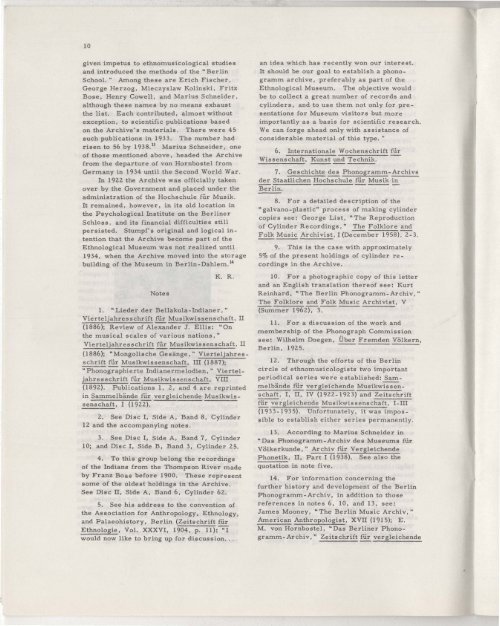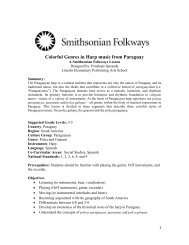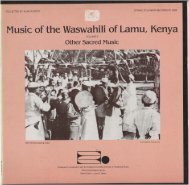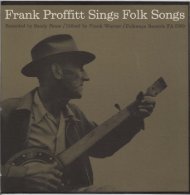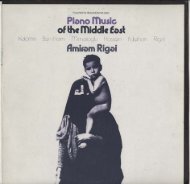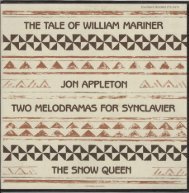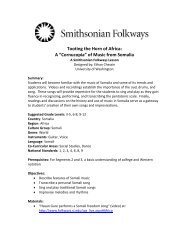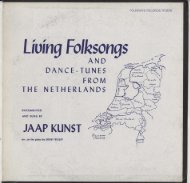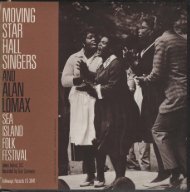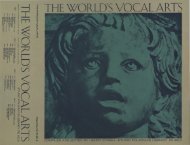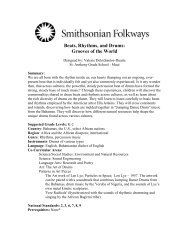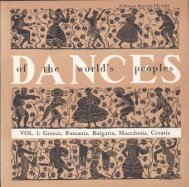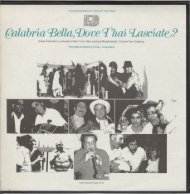FW04175.pdf
FW04175.pdf
FW04175.pdf
Erfolgreiche ePaper selbst erstellen
Machen Sie aus Ihren PDF Publikationen ein blätterbares Flipbook mit unserer einzigartigen Google optimierten e-Paper Software.
10given impetus to ethnomusicological studiesand introduced the methods of the" BerlinSchool." Among these are Erich Fischer,George Herzog, Mieczyslaw Kolinski, FritzBose, Henry Cowell, and Marius Schneider,although these names by no means exhaustthe list. Each contributed, almost withoutexception, to scientific publications basedon the Archive's materials. There were 45such publications in 1933. The number hadrisen to 56 by 1938. 13 Marius Schneider, oneof those mentioned above, headed the Archivefrom the departure of von Hornbostel fromGermany in 1934 until the Second World War.In 1922 the Archive was officially takenover by the Government and placed under theadministration of the Hochschule fur Musik.It remained, however, in its old location inthe Psychological Institute on the BerlinerSchloss , and its financial difficultie s stillpersisted. Stumpf's original and logical intentionthat the Archive become part of theEthnological Museum was not realized until1934, when the Archive moved into the storagebuilding of the Museum in Berlin-Dahlem. 14NotesK. R.1. "Lieder der Bellakula-Indianer , ..Vierteljahresschrift fur Musikwissenschaft, II(1886); Review of Alexander J. Ellis: "Onthe musical scales of various nations, ..Vierteljahresschrift fur Musikwissenschaft, II(1886); "Mongolische Gesange," Vierteljahresschriftfur Musikwissenschaft, III (1887);"Phonographierte Indianermelodien, .. Vierteljahresschriftfur Musikwissenschaft, VIII(1892). Publications 1, 2 , and 4 are reprintedin Sammelbande fur vergleichende Musikwissenschaft,I (1922)."2. See Disc I, Side A, Band 8, Cylinder12 and the accompanying notes.3. See Disc I, Side A, Band 7, Cylinder10; and Disc I, Side B, Band 3, Cylinder 25.4 . To this group belong the recordingsof the Indians from the Thompson River madeby Franz Boas before 1900. These representsome of the oldest holdings in the Archive.See Disc II, Side A, Band 6, Cylinder 62.5. See his address to the convention ofthe Association for Anthropology, Ethnology,and Palaeohistory, Berlin (Zeitschrift furEthnologie, Vol. XXXVI, 1904, p. 11):"'71would now like to bring up for discussion ...an idea which has recently won our interest.It should be our goal to establish a phonogrammarchive, preferably as part of theEthnological Museum. The objective wouldbe to collect a great number of records andcylinders, and to use them not only for presentationsfor Museum visitors but moreimportantly as a basis for scientific research.We can forge ahead only with assistance ofconsiderable material of this type . ..6. Internationale Wochenschrift furWissenschaft, Kunst und Technik.7. Geschichte des Phonogramm-Archivsder Staatlichen Hochschule fur Musik inBerlin.8 . For a detailed de scription of the"galvano-plastic" process of making cylindercopies see: George List, "The Reproductionof Cylinder Recordings," The Folklore andFolk Music Archivist, I (De~ber 1958)T-3.9. This is the case with approximately50/0 of the present holdings of cylinder recordingsin the Archive.10. For a photographic copy of this letterand an English translation thereof see: KurtReinhard, "The Berlin Phonogramm-Archiv,"The Folklore and Folk Music Archivist, V(Summer 1962), 3-. -----11. For a discussion of the work andmembership of the Phonograph Commissionsee: Wilhelm Doegen, tiber Fremden Volkern,Berlin, 1925. --12. Through the efforts of the Berlincircle of ethnomusicologists two importantperiodical series were established: Sammelbandefur vergleichende Musikw~nschaft,I, II, IV (1922-1923) and Zeitschriftfur vergleichende Musikwissenschaft, I-III(1933-1935). Unfortunately, it was impossibleto establish either series permanently.13. According to Marius Schneider in"Das Phonogramm-Archiv des Museums furVolkerkunde," Archiv fur VergleichendePhonetik, II, Part I (1938). See also thequotation in note five.14. For information concerning thefurther history and development of the BerlinPhonogramm-Archiv, in addition to thosereferences in notes 6, 10, and 13, see:James Mooney, "The Berlin Music Archiv, ..American Anthropologist, XVII (1915); E .M . von Hornbostel, "Das Berliner Phonogramm-Archiv," Zeitschrift fur vergleichende


